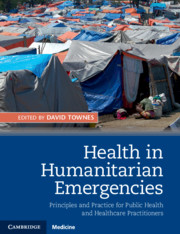 Health in Humanitarian Emergencies
Health in Humanitarian Emergencies Book contents
- Health in Humanitarian Emergencies
- Health in Humanitarian Emergencies
- Copyright page
- Dedication
- Contents
- Contributors
- Foreword
- Abbreviations
- Section 1 Humanitarian Emergencies
- Chapter 1 Introduction to Humanitarian Emergencies
- Chapter 2 History of Humanitarian Emergencies
- Chapter 3 Who’s Who in Humanitarian Emergencies
- Chapter 4 Response to Humanitarian Emergencies
- Chapter 5 Epidemiology
- Chapter 6 Ethics
- Section II Public Health Principles
- Section III Illness and Injury
- Index
- References
Chapter 4 - Response to Humanitarian Emergencies
from Section 1 - Humanitarian Emergencies
Published online by Cambridge University Press: 26 July 2018
- Health in Humanitarian Emergencies
- Health in Humanitarian Emergencies
- Copyright page
- Dedication
- Contents
- Contributors
- Foreword
- Abbreviations
- Section 1 Humanitarian Emergencies
- Chapter 1 Introduction to Humanitarian Emergencies
- Chapter 2 History of Humanitarian Emergencies
- Chapter 3 Who’s Who in Humanitarian Emergencies
- Chapter 4 Response to Humanitarian Emergencies
- Chapter 5 Epidemiology
- Chapter 6 Ethics
- Section II Public Health Principles
- Section III Illness and Injury
- Index
- References
- Type
- Chapter
- Information
- Health in Humanitarian EmergenciesPrinciples and Practice for Public Health and Healthcare Practitioners, pp. 35 - 52Publisher: Cambridge University PressPrint publication year: 2018


